MARIANI’SVirtual
Gourmet
September
1, 2013
NEWSLETTER
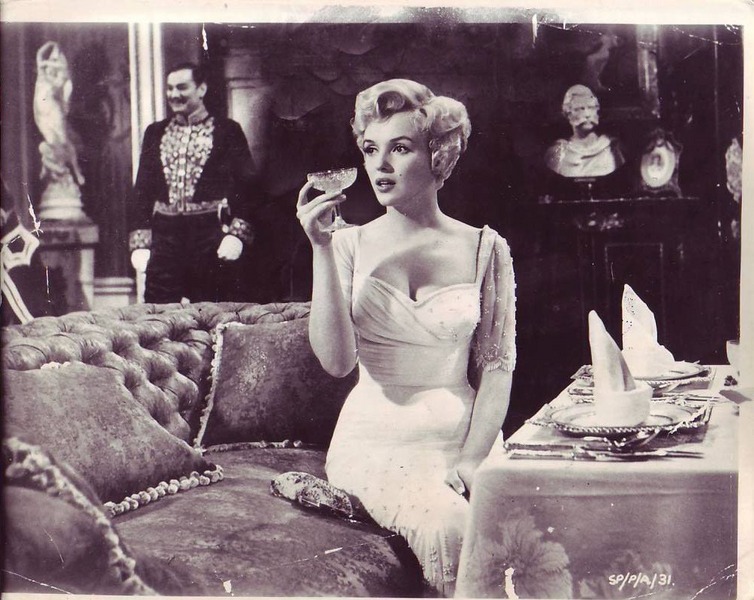
Marilyn
Monroe in "The Prince and the Showgirl" (1957)
❖❖❖
THIS WEEK
In the
Hills of the Cotswolds
by John Mariani
NEW
YORK CORNER
Costata
by John Mariani
❖❖❖
by John Mariani
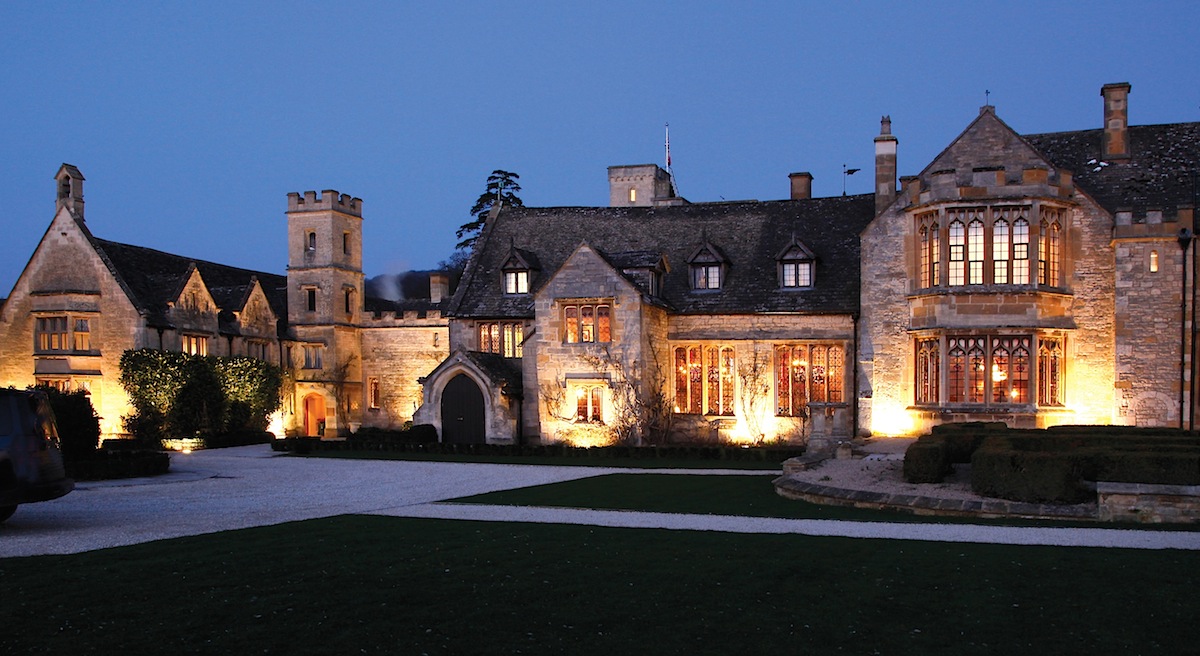
Worldwide
devotees
of the TV series “Downton Abbey” might well wonder
if anything quite like that grandeur of man and
nature still abides in England and if the great
houses are still in good enough shape to visit.
Indeed, their rarity makes the allure of
actually staying at one a reverie of nostalgia and
class. But in the Cotswolds region, which takes in
the counties of Gloucestershire and Oxfordshire, the
opportunity to stay at one of those grand estates is
a mere few hours from London’s Paddington Station
(90 minutes by train).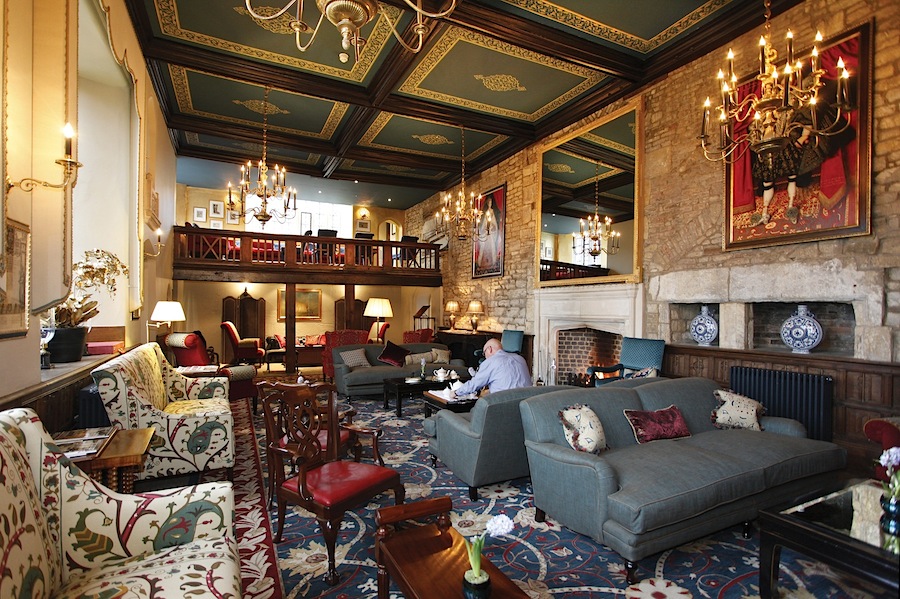
You arrive in Cheltenham, and a
five minutes’ drive takes you to the glorious Ellenborough
Park, whose most modern amenities and
excellent restaurants co-exist within an atmosphere
of long British history, most readily felt in the
estate’s Great Hall (right), decorated by designer Nina
Campbell. Having tea, cocktails or nightcaps in this
splendid room can certainly make you feel like a
Downton Abbey heir, with its Minstrels Gallery and
an intimate room for tending to business or penning
a letter on signature stationary.
The 60 bedrooms are very
spacious, blissfully quiet, and a blend of British
country style and modern comfort, with large
bathrooms and sofas you can sink into while reading
British Vogue.
There is, of course, a very up-to-date spa and
lovely outdoor pool. One touch every guests passes
through and smiles at is the outfitting room (below), where
you can rent riding boots and gear. Nice touch.
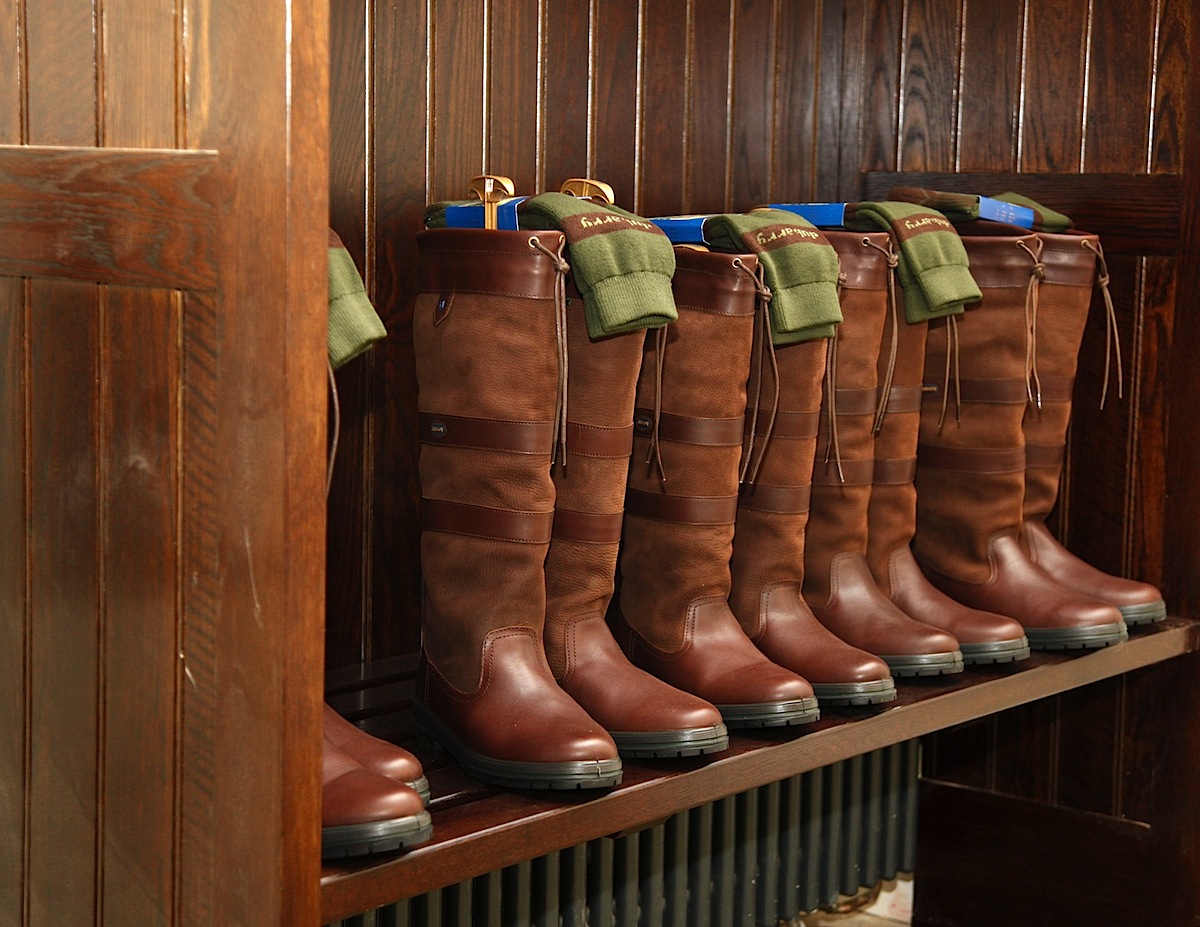 The attention to a guest’s
comfort is paramount among the young staff that
ministers to you during your stay, overseen by
omnipresent general manager John Hanna.
The attention to a guest’s
comfort is paramount among the young staff that
ministers to you during your stay, overseen by
omnipresent general manager John Hanna.
The dining options at
Ellenborough are the casual Brasserie, with a simple
menu of British and global foods, and the Beaufort
Dining Room. I had lunch in the former restaurant, a
rustic, stone-walled room with a fireplace, bentwood
captain’s chairs and a menu that properly begins
with a chicken liver pâté with Melba
toast, then pan-fried rump steak with hand-cut chips
(French fries), along with Lock Fynbe smoked salmon;
and Cotswolds sausage with baked potato mash and 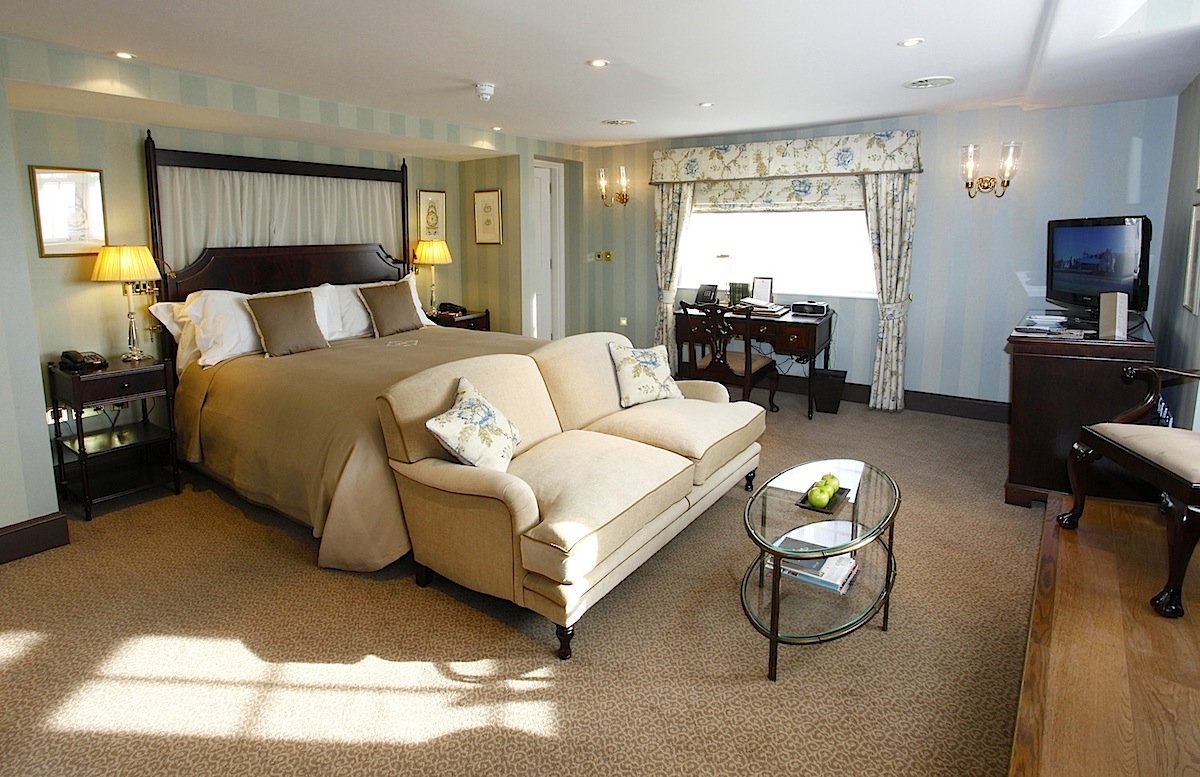 onion confit
jus.
onion confit
jus.
The more formal, but not in the
least stuffy, Beaufort Dining Room (below), is
where you will feel cosseted in the best,
old-fashioned way of British manners. And while
Welsh-born Chef David Kelman revels in British
tradition and the finest ingredients available, he
has a sense of creativity that shows a delicate
balance of the classic and the new.
When I was there, basking in an
ambiance of ancient wood paneling, with stained
Oriel windows and Tudor fireplaces, the tables set
with thick linens, specially made bone china, fine
stem- and silverware, I perused the well-priced wine
list and cast a glad eye towards a cheese cart
brimming with English and Irish offerings you don’t
often find much anymore. The fixed price menus are
amazingly modest in price--two courses £45 per
person, three £55, four £65.
In London, for this degree of posh, service
and cuisine, you’d have to add ₤50 at least.
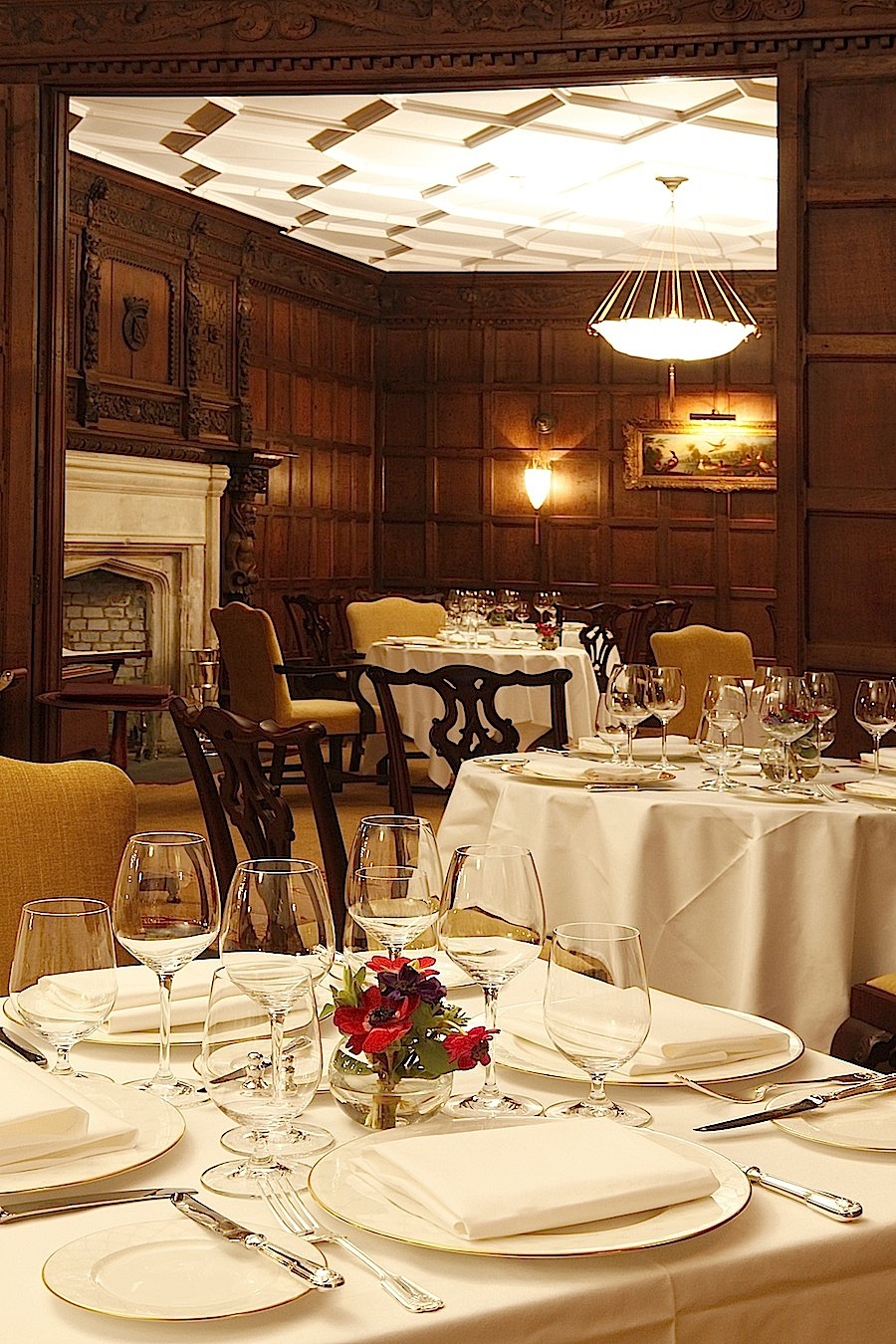 My
table of three began with spring asparagus with a
soft-poached pheasant’s egg, fresh peas and a
gossamer-light fennel hollandaise dressing. Wild
black bream and South Coast crab came with wild
asparagus, creamy crab mayonnaise and baby spinach—a
generous appetizer—and pan-fried scallops came with
the deft addition of carrot and golden raisin salsa,
coriander shoots and carrot crisp.
My
table of three began with spring asparagus with a
soft-poached pheasant’s egg, fresh peas and a
gossamer-light fennel hollandaise dressing. Wild
black bream and South Coast crab came with wild
asparagus, creamy crab mayonnaise and baby spinach—a
generous appetizer—and pan-fried scallops came with
the deft addition of carrot and golden raisin salsa,
coriander shoots and carrot crisp.
The main courses included a roast
breast of local Creedy Carver duck with a tangy
sweet, bitter side of orange-braised chicory,
potatoes scented with thyme, morel mushrooms and an
assertive raspberry vinegar jus. A
delicate hand in the kitchen rendered a pan-fried
filet of bass to perfect succulence, with baby
spinach, parsley root puree, white asparagus that
was just then coming into season, and a creamed
shellfish tartlet. This sounds like an awfully
heavy dish, but instead it had a finesse that
satisfied without sating the appetite. Distinctively
hefty, though, was a spiced loin of slow-roasted
belly of Old Spot pork with a fricassée of
peas and broad beans, apple relish and sage jus.
Then came the cheese! Wheeled
over ceremoniously and presented 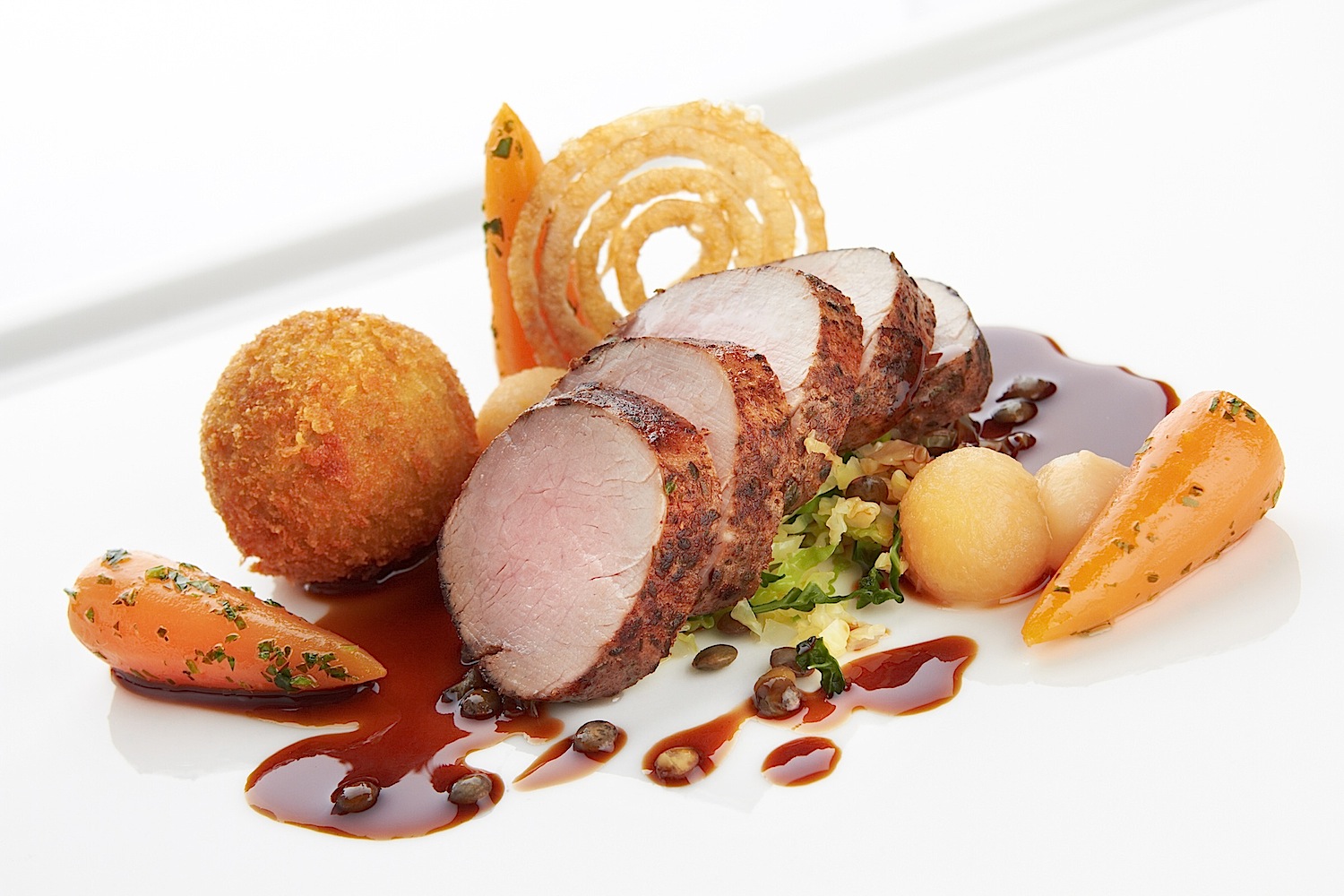 with
Dickensian flourish, there were more than a dozen of
them in peak condition, with wonderful names like
Isle of Mull Cheddar, Wyfe of Bath Kersey, and
Gorwydd Caerphilly. I pounced.
with
Dickensian flourish, there were more than a dozen of
them in peak condition, with wonderful names like
Isle of Mull Cheddar, Wyfe of Bath Kersey, and
Gorwydd Caerphilly. I pounced.
But I did leave room for a
dessert or two, including a fig sorbet and vanilla
baked Alaska—a silly old 19th century favorite that
was here enlivened with Mandarine Napoleon brandy. A
tot of Port afterwards in the Great Hall, a stroll
in the moonlight, breathing the fresh Cotswold air,
and sleep came quickly that night.
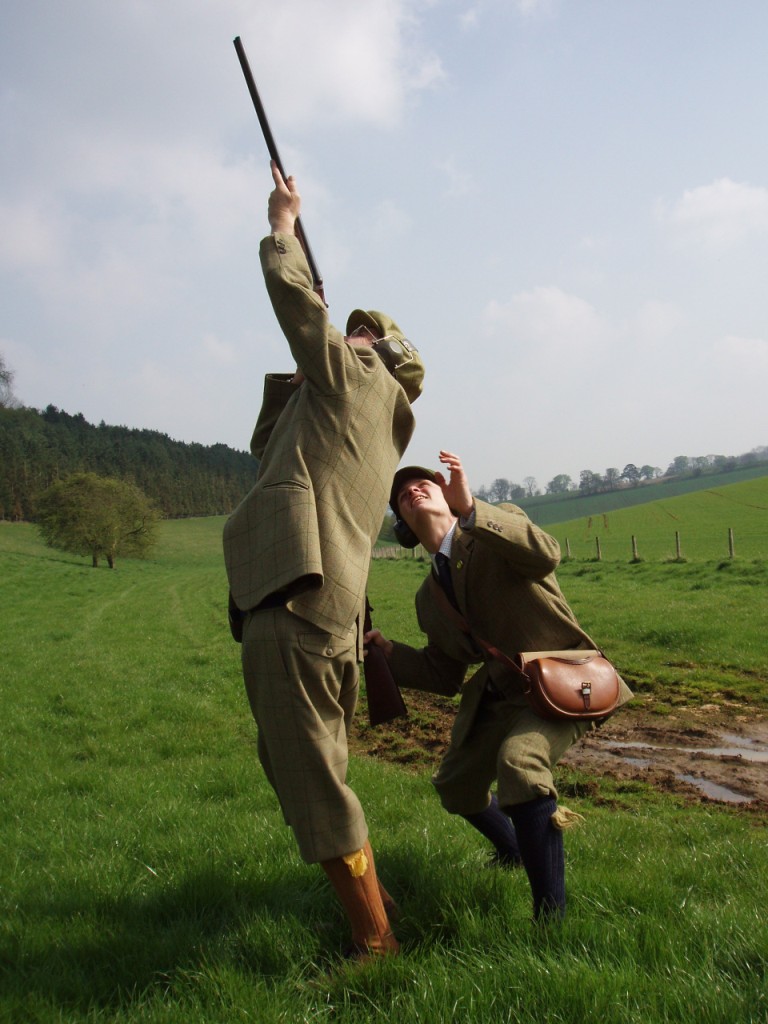 The next
morning I was up and out for some clay pigeon
shooting—not an avocation of mine, but one that
seemed right for the weekend. Donning tweeds and
cavalry twill for the occasion and borrowing a wool
cap, I drove to Ian Coley
Shooting School (left) near Andoversford, and, with
a tutor, managed not to embarrass myself with a
powerful Beretta shot gun, blowing the clay rounds
out of the sky and managing not to hit the side of a
barn. My ears
were ringing for days from the sound of the gun. As one might have mumbled a
century ago, a ripping afternoon.
The next
morning I was up and out for some clay pigeon
shooting—not an avocation of mine, but one that
seemed right for the weekend. Donning tweeds and
cavalry twill for the occasion and borrowing a wool
cap, I drove to Ian Coley
Shooting School (left) near Andoversford, and, with
a tutor, managed not to embarrass myself with a
powerful Beretta shot gun, blowing the clay rounds
out of the sky and managing not to hit the side of a
barn. My ears
were ringing for days from the sound of the gun. As one might have mumbled a
century ago, a ripping afternoon.
Incidentally, if you forgot to
bring your own tweeds or other shooting togs, they
sell them at 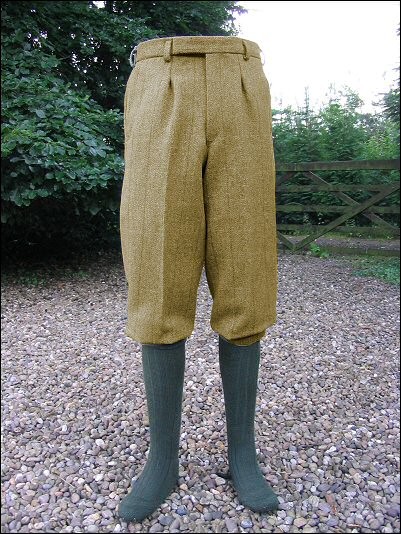 the School,
from Barrington
Ayre shirtmaker and tailor, with a superb
selection of British mill wools that will put you in
mind of all those photos of the Royal Family on
their hunting grounds. They even carry Derby Tweed
Breeks, the knee-length britches and long socks (right) that
were all the rage in the 1880s.
the School,
from Barrington
Ayre shirtmaker and tailor, with a superb
selection of British mill wools that will put you in
mind of all those photos of the Royal Family on
their hunting grounds. They even carry Derby Tweed
Breeks, the knee-length britches and long socks (right) that
were all the rage in the 1880s.
The Cotswolds, though only 90
miles long and 25 wide, are home to hundreds of
little towns, some more picturesque than others, as
well as large tourist cities like Bath, now prettier
than it was for so many post-war years when British
“Kitchen Sink” movies were filmed here. Many
of the houses in the Cotswold are built from the
local pale-gold limestone, and, this being farm
country still, ancient stone walls keep in the herds
of sheep, famous for their fat, flavor and wool.
It
is hilly countryside, the very definition of the
word bucolic, and puts one in mind of Christopher
Marlowe’s idyllic 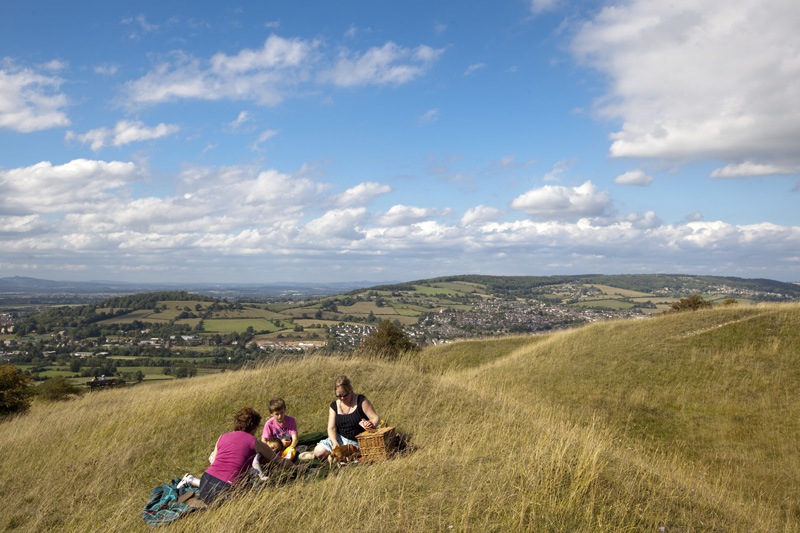 lyric “The
Passionate Shepherd to His Love”:
lyric “The
Passionate Shepherd to His Love”:
Come live with me and be my
love,
And we will all the pleasures prove
That valleys, groves, hills, and fields,
Woods or steepy mountain yields.
And
we will sit upon the rocks,
Seeing the shepherds feed their flocks,
By shallow rivers to whose falls
Melodious birds sing madrigals.
There are true
castles in the area worth visiting, including Sudeley
(below)
once the home of Catherine Parr (1512-1548), Henry
VIII’s last wife, where she is now buried.
Though still a private residence, arrangements
can be made to visit.
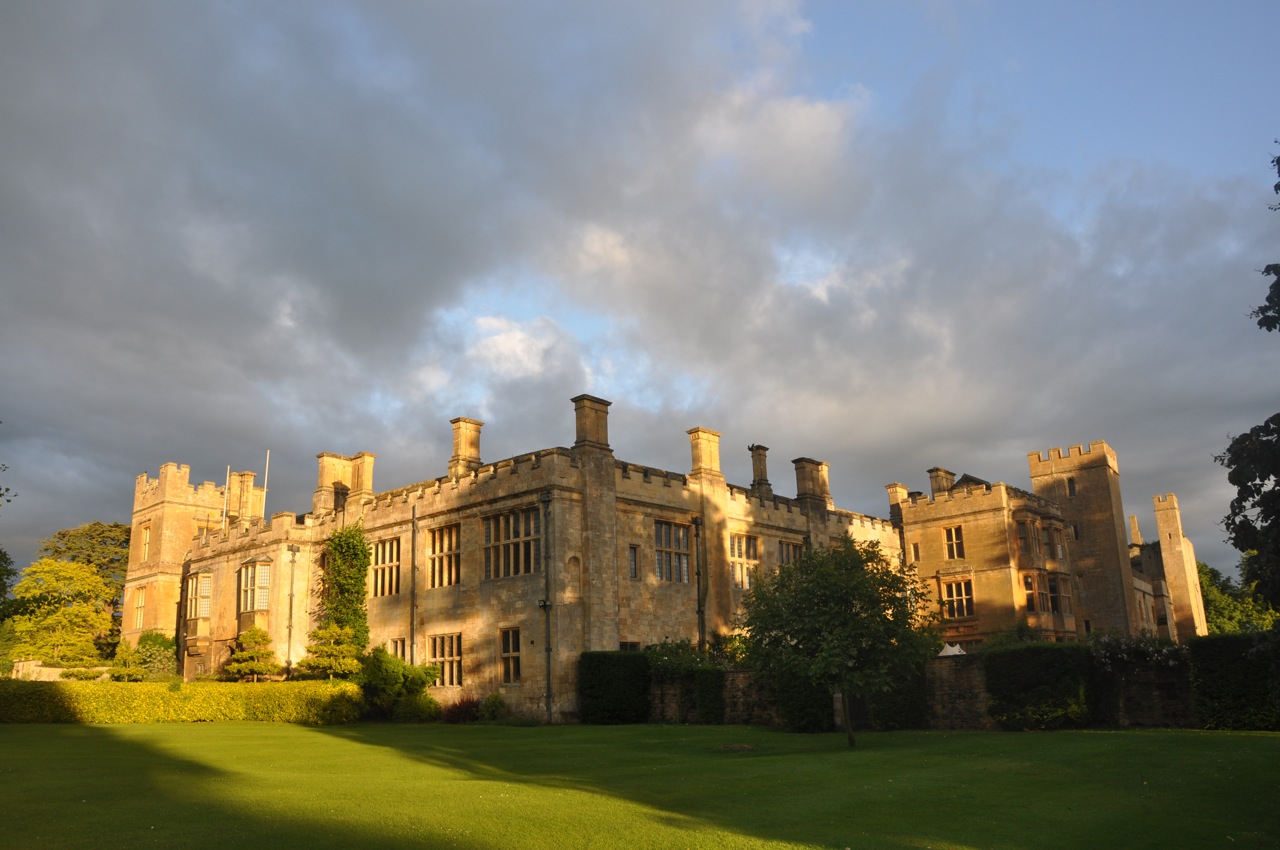 And what
about Downton Abbey, supposedly set in Yorkshire?
The stand-in was actually Highclere
Castle (below)
in Hampshire, which is about 90 miles from
Ellenborough Park, so well within a day’s driving
distance. The owners, the Earl and Countess of
Carnarvon, have again opened the castle to the
public in summer. Booking far in advance is a must.
And what
about Downton Abbey, supposedly set in Yorkshire?
The stand-in was actually Highclere
Castle (below)
in Hampshire, which is about 90 miles from
Ellenborough Park, so well within a day’s driving
distance. The owners, the Earl and Countess of
Carnarvon, have again opened the castle to the
public in summer. Booking far in advance is a must.
Last but certainly not least, it
is easy enough from Cheltenham to visit Oxford
University, a mere hour’s drive. Contemporary Oxford
itself has few quaint charms—and lots of t-shirt
shops—but the vine-clad University itself is a
magnificent amalgam of architectural styles,
and the Ashmolean Museum, with works by Da Vinci and
Michelangelo, is a must-see. There is also a
fine Museum of 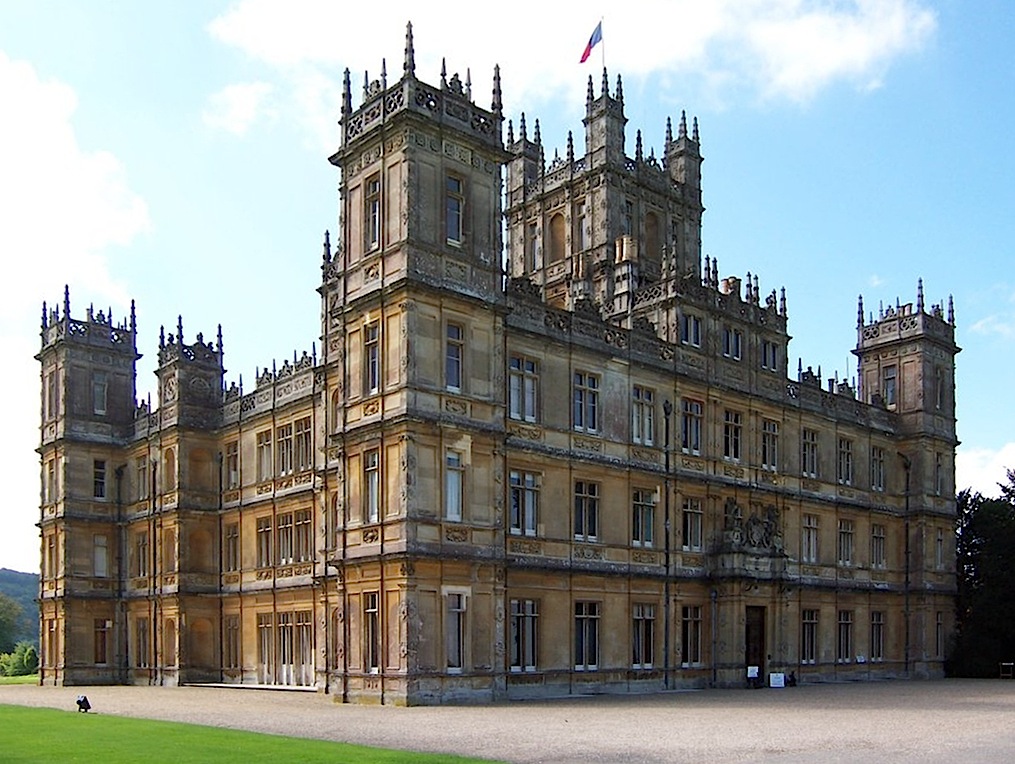 Natural History, the great
Bodleian Library, the Museum of Science, and 70
acres of parkland for strolling, along with
England’s oldest botanic garden and, close by, the
Harcourt Arboretum spread over 130 acres.
Natural History, the great
Bodleian Library, the Museum of Science, and 70
acres of parkland for strolling, along with
England’s oldest botanic garden and, close by, the
Harcourt Arboretum spread over 130 acres.
 I
have never been one to rough it in search of dusty
antiquity—an afternoon visit to underground
catacombs should always lead to a good dinner and
room at night—and throughout the Cotswolds, the
palpable sense that the history of rural England is
still embodied in the hillsides, the copses, the
sheep fields and the architecture of places like
Ellenborough Park makes this a uniquely beautiful
region, of a kind that Shakespeare called “the envy
of less happier lands,
This blessed plot, this
earth, this realm, this England.”
I
have never been one to rough it in search of dusty
antiquity—an afternoon visit to underground
catacombs should always lead to a good dinner and
room at night—and throughout the Cotswolds, the
palpable sense that the history of rural England is
still embodied in the hillsides, the copses, the
sheep fields and the architecture of places like
Ellenborough Park makes this a uniquely beautiful
region, of a kind that Shakespeare called “the envy
of less happier lands,
This blessed plot, this
earth, this realm, this England.”
NB: The Cotswolds is
often spelled as "Cotswold," and I have no idea why.
National Express network offers a range of
discount fares and trail passes for coach travel.
The main route to the Cotswold from London starts
at Victoria Coach Station, takes about 3 - 4 hours
and costs about £17. The main coach stops in
and around the Cotswold are at Bath,
Bourton-on-the-Water, Cheltenham, Chippenham,
Gloucester, Moreton-in-Marsh, Northleach, Oxford,
Stow-on-the-Wold, Stratford-upon-Avon, Stroud.
❖❖❖
by John Mariani
COSTATA
206 Spring Street (off the Avenue of the Americas)
212-334-3320
costatanyc.com
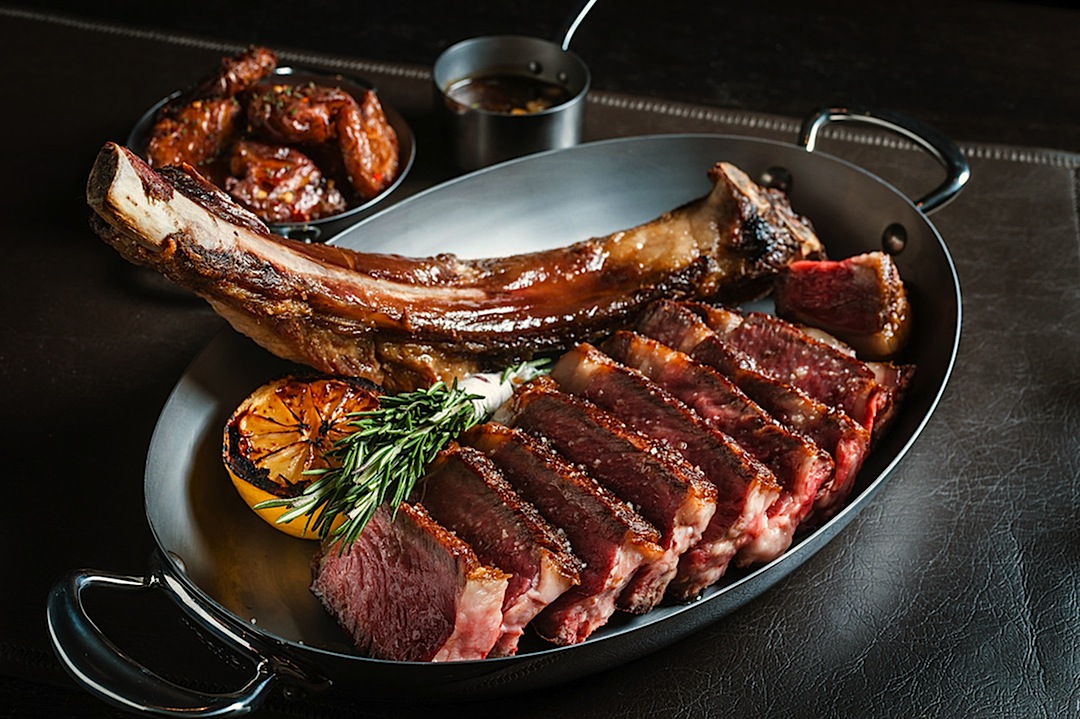 Michael White has been
opening new restaurants at a furious pace—four
this year alone, though there are still four
months to go.
Michael White has been
opening new restaurants at a furious pace—four
this year alone, though there are still four
months to go.
Since
opening the fine dining room Ai Fiori two years
ago, his efforts have been more casual, like
Morini Trattoria, and a couple of pizzerias.
But, since everyone else is opening
steakhouses—Mario Batali, Tom Colicchio, Gordon
Ramsay and others—why shouldn’t he? And to put his
own stamp on it, White’s given it a touch more
Italian swagger. Thus, Costata, which in
Italian means a ribeye cut (left).
This
is something of a homecoming for White (below), who first established his
rep on the same Soho premises, when it was called
Fiamma, which he was not a partner in. After that,
he scored big with the Italian seafood ristorante Marea; by then his fortunes
were assured and his investors grew in number,
leading to such furious, current expansion,
including an Italian restaurant in Hong Kong
called Al Molo. Just how much attention
White is, therefore, able to pay to any and all
his ventures is anyone’s guess, but Costata, at
least, is a creditable addition to the already
super-saturated NYC steakhouse scene.
There
are three levels at Costata, the third for private
dining. I dined at the lowest level on a
very quiet Monday night, with only half the tables
occupied all night, despite the food media’s
insistence that this is a very tough table to get at all.
The place is appropriately masculine,
swathed in wood paneling, with admirable
tablecloths, and huge lampshades overhead to
spread the light and allow you to see everyone
else. The table candles in glass are cheap
looking. The music, not loud the night I dined, is
‘70s and ‘80s rock. Always nice to hear Fleetwood
Mac again.
Service is highly professional, and the 25-page
wine list is, as at all White’s restaurants,
solid, and, while not cheap, there are some good
bottlings under $60 here.
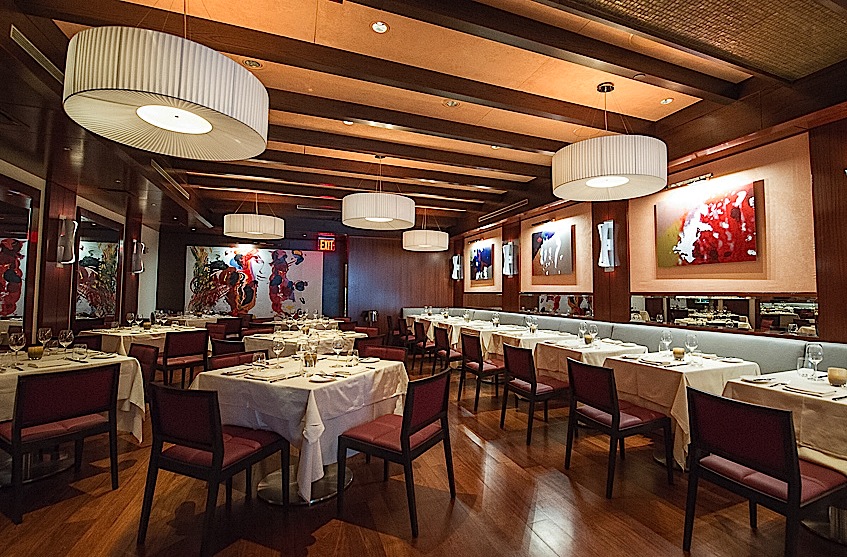
The
menu is not breaking any new ground for either a
steakhouse or for White; indeed, White reprises
several of his hits from other restaurants,
including an extensive crudi (below) section
of pristine, raw seafood. I very much enjoyed
the amberjack dolled up with Calabrian chilies and
pickled cauliflower. The “caviar” offerings—from
California and Florida—are awfully expensive for
domestic product at $100 and $120 per ounce.
An appetizer of quail
saltimbocca, wrapped with pancetta and sage, was
good and juicy, but a lobster cocktail all’amatriciana,
despite spicy horseradish and guanciale,
would have been better warm than cold. White’s
pastas are always a high point, and there was no
arguing that point when it comes to a sublimely rich
ridged garganelli
lavished with peas, Speck,
radicchio and truffle cream. Nicely al dente
spaghetti with clams would have been a lot more
rewarding had there been more of the promised vongole and
razor clams, which were out of the shell to begin
with.
There are several steak
offerings, including three served for two people.
Our table shared a consummately flavorful 44
ounce costata
at $59 per person, considerably
less than Minetta Tavern’s cote de boeuf at
$70 (and they both use the same butcher). This is
truly a great piece of beef, with the bone, which we
most certainly took home—and we have no dog with
which to share it. Oddly enough, as more than one
other food writer has remarked, the lamb chops ($49)
at Costata are not up to snuff, lacking in lamb
flavor.
per person, considerably
less than Minetta Tavern’s cote de boeuf at
$70 (and they both use the same butcher). This is
truly a great piece of beef, with the bone, which we
most certainly took home—and we have no dog with
which to share it. Oddly enough, as more than one
other food writer has remarked, the lamb chops ($49)
at Costata are not up to snuff, lacking in lamb
flavor.
Desserts are fairly refined
versions of what you’ll find elsewhere, but I’d
recommend the gelati,
which seem just about right at the end of a big
meal.
White
himself has a big Midwestern personality, and he has
invested himself in the past in his restaurants as a
presence to be anticipated and welcomed. With so
many ventures now part of his growing empire, the
chances of seeing him at any of them grow dim.
Costata does what it does well, but it needs an
infusion of personality and more attention to detail
and diversity.
Costata is open for dinner nightly; Appetizers and pasta, $14 to $24; main courses, $33 to $59.
❖❖❖
HE DUH
PRINCE! HE ALSO DUH CHEAPSKATE!
 VIVID FOOD WRITING, PART 5,446
VIVID FOOD WRITING, PART 5,446
"Natural redwood and a woman’s smile reflect in sparkling ceiling-high mirrors. A guy drapes his lap with a white linen napkin. The dining room bustles. The patio blooms. At every turn, Rustic Tavern melds masculine with the feminine."--Cal Foster, "Rustic Tavern," Diablo.
❖❖❖
Any of John Mariani's
books below may be ordered from amazon.com.
 |
My latest book, which just won the prize for best book from International Gourmand, written with Jim Heimann and Steven Heller, Menu Design in America, 1850-1985 (Taschen Books), has just appeared, with nearly 1,000 beautiful, historic, hilarious, sometimes shocking menus dating back to before the Civil War and going through the Gilded Age, the Jazz Age, the Depression, the nightclub era of the 1930s and 1940s, the Space Age era, and the age when menus were a form of advertising in innovative explosions of color and modern design. The book is a chronicle of changing tastes and mores and says as much about America as about its food and drink.
“Luxuriating vicariously in the pleasures of this book. . . you can’t help but become hungry. . .for the food of course, but also for something more: the bygone days of our country’s splendidly rich and complex past. Epicureans of both good food and artful design will do well to make it their coffee table’s main course.”—Chip Kidd, Wall Street Journal.
“[The menus] reflect the amazing craftsmanship that many restaurants applied to their bills of fare, and suggest that today’s restaurateurs could learn a lot from their predecessors.”—Rebecca Marx, The Village Voice. |
"Eating Italian will never be the same after reading John Mariani's entertaining and savory gastronomical history of the cuisine of Italy and how it won over appetites worldwide. . . . This book is such a tasteful narrative that it will literally make you hungry for Italian food and arouse your appetite for gastronomical history."--Don Oldenburg, USA Today. "Italian
restaurants--some good, some glitzy--far
outnumber their French rivals. Many of
these establishments are zestfully described
in How Italian Food Conquered the World, an
entertaining and fact-filled chronicle by
food-and-wine correspondent John F.
Mariani."--Aram Bakshian Jr., Wall Street
Journal.
"Equal parts
history, sociology, gastronomy, and just
plain fun, How Italian Food Conquered the
World tells the captivating and delicious
story of the (let's face it) everybody's
favorite cuisine with clarity, verve and
more than one surprise."--Colman Andrews,
editorial director of The Daily
Meal.com. "A fantastic and fascinating
read, covering everything from the influence
of Venice's spice trade to the impact of
Italian immigrants in America and the
evolution of alta cucina. This book will
serve as a terrific resource to anyone
interested in the real story of Italian
food."--Mary Ann Esposito, host of PBS-TV's
Ciao
Italia. "John Mariani has written the
definitive history of how Italians won their
way into our hearts, minds, and
stomachs. It's a story of pleasure over
pomp and taste over technique."--Danny Meyer,
owner of NYC restaurants Union Square Cafe,
Gotham Bar & Grill, The Modern, and
Maialino.
|
 |
 |
 |
 |
 |
 |
 |
 |
 Everett Potter's Travel Report:
Everett Potter's Travel Report: 
 Eating Las Vegas
is the new on-line site for Virtual Gourmet
contributor John A. Curtas., who since 1995
has been commenting on the Las Vegas food
scene and reviewing restaurants for Nevada
Public Radio. He is also the
restaurant critic for KLAS TV, Channel 8 in
Las Vegas, and his past reviews can be
accessed at KNPR.org.
Click on the logo below to go directly to
his site.
Eating Las Vegas
is the new on-line site for Virtual Gourmet
contributor John A. Curtas., who since 1995
has been commenting on the Las Vegas food
scene and reviewing restaurants for Nevada
Public Radio. He is also the
restaurant critic for KLAS TV, Channel 8 in
Las Vegas, and his past reviews can be
accessed at KNPR.org.
Click on the logo below to go directly to
his site.

Tennis Resorts Online: A Critical Guide to the World's Best Tennis Resorts and Tennis Camps, published by ROGER COX, who has spent more than two decades writing about tennis travel, including a 17-year stretch for Tennis magazine. He has also written for Arthur Frommer's Budget Travel, New York Magazine, Travel & Leisure, Esquire, Money, USTA Magazine, Men's Journal, and The Robb Report. He has authored two books-The World's Best Tennis Vacations (Stephen Greene Press/Viking Penguin, 1990) and The Best Places to Stay in the Rockies (Houghton Mifflin, 1992 & 1994), and the Melbourne (Australia) chapter to the Wall Street Journal Business Guide to Cities of the Pacific Rim (Fodor's Travel Guides, 1991).


MARIANI'S VIRTUAL GOURMET
NEWSLETTER is published weekly. Editor/Publisher: John
Mariani.
Contributing Writers: Christopher Mariani, Robert Mariani,
John A. Curtas, Edward Brivio, Mort Hochstein,
Suzanne Wright, and Brian Freedman. Contributing
Photographers: Galina Stepanoff-Dargery,
Bobby Pirillo. Technical Advisor: Gerry McLoughlin.
© copyright John Mariani 2013
